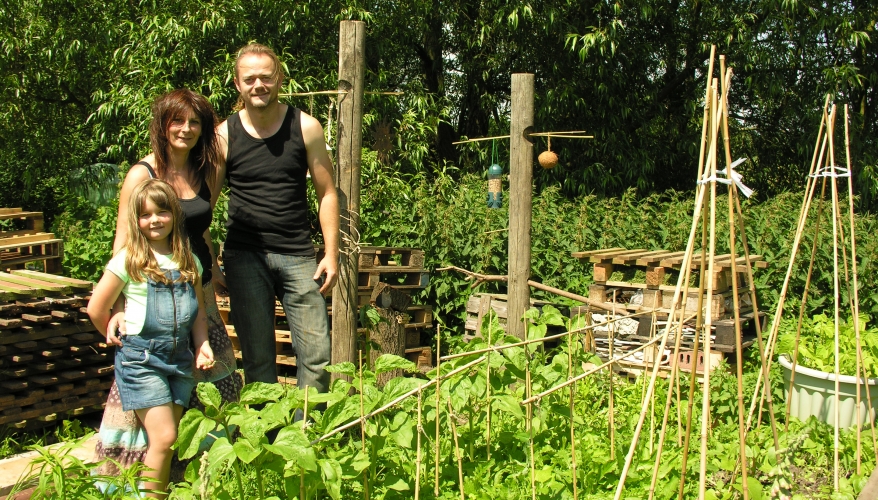The entrance to Kevin Yarwood’s family home is along a leafy green towpath, with ducks and swans gliding idly by on the water. The pathway suddenly clears to a lovely space with a mown lawn and carefully tended vegetable garden alongside an elegant narrowboat named ‘Meander’.
Kevin is the Manager at Anglo Welsh Waterways in Great Haywood, so his office is literally on the doorstep of his home. He has a permanent mooring licence for his boat, so ‘Meander’ is now home to Kevin, his new wife Amanda, and her two children Brogan and Ilona. Oh, and the family dog, Jazz.
“I’ve worked here for twenty years,” says Kevin, “but I’ve only lived on a boat for the past two years. I started as a ‘yard lad’, aged twelve. ‘Meander’ belonged to a good friend of mine, who, sadly, died, and I’d always loved his boat, so when it came up for sale, I bought it. Now, I don’t think I could live in a normal house again. You’re so close to nature here and the wildlife is just amazing. On a sunny weekend it’s wonderful to just start the engine and travel through some beautiful countryside.”
Amanda has adapted to boat living quickly too, and doesn’t miss having more space. “I’d always wanted to live on a boat. I like the fact that everything is close. Whenever I’m in a house now as a visitor, I find it odd that the TV is so far away, and there is so much space. I don’t like it. You have to get on with each other for it to work on a boat, of course, and fortunately, we all do.”
Amanda found editing her wardrobe an easy task. “Like a lot of women, I used to have loads of clothes but only ever wore the same few outfits. Now I just have a few things and don’t miss the other clothes that used to gather dust in my wardrobe.”
The boat comprises a bedroom for Ilona with a double bed, a bathroom with a full size bath, and a spacious kitchen/living area that cleverly turns into Kevin and Amanda’s bedroom at night. The ‘dining room’ is outside amongst the trees and flowers. There’s plenty of room for indoor dining on the boat when the weather gets colder but the family prefers to eat in the open. “We love eating outdoors,” says Amanda. “Just look at the view. Who needs TV dinners when you have all this in your own back garden?”
The children both go to local schools and their friends love to visit them on the boat. Brogan spends part of the week living with his father nearby, and then part of the week on the boat with his mum and step-dad. “You have to be able to swim if you live on a boat”, says Brogan, “for safety reasons. It’s nice being able to go on trips for the day on the boat instead of in a car.”
“I like not having to go downstairs to get my breakfast”, explains Ilona. “The kitchen is near to my bedroom on the boat and I like that. And I like travelling when it’s sunny.”
Kevin has a multi-fuel burner on the boat which is fitted with a clever little eco-fan. The fan enables the heat from the burner to be distributed around the boat for maximum efficiency and super-cosiness. Burners on narrowboats can otherwise belt out far too much heat in one place and leave the rest of the boat freezing and needing extra heating. Kevin recently purchased two solar panels which sit neatly on the top of the boat. “I fitted them myself, and have been amazed at how quickly they worked – and how well. They’re quiet, and will save us a lot of money in fuel in a relatively short time. They charge the batteries on the boat and give us lots of hot water and electricity – silently.”
Amanda notes that the cooker uses just three bottles of gas per year, and the burner uses wood which they collect themselves from the surrounding area. They have a TV, internet, cooker, fridge, washing machine and Amanda even has her hairdryer and straighteners. “We don’t need a dishwasher,” says Amanda, “but we do enjoy the luxury of a toaster. It’s our treat! We do a weekly shop instead of a monthly shop and basically buy what we need when we need it so we’re not wasting space.”
The Yarwoods have transformed the towpath from a dense, unkempt thatch of nettles, into a little oasis, with fruit trees, a vegetable patch, a small pond, bird boxes and ‘bug hotels’ – deliberately placed piles of wood to encourage and provide a home for wildlife. Chaffinches, bluetits, robins, herons and butterflies are regular visitors. “We’re trying to encourage bees too,” says Amanda, “because we know they’ve been in decline.”
Ilona ponders what the best thing is about living on a boat. “Well, if you lived in a house you wouldn’t be able to feed the ducks from your bedroom window, would you?”
“I spent six years looking for the right boat”, say Kevin. “I never imagined I’d end up living in my friend’s boat. He would have loved to know it’s now a family home and still has a connection to him. We’re very happy here. ”
If you’re thinking of buying a boat or living on one, it’s important to do your homework, and most importantly, to try it out first. Here are some helpful websites to get you started:
The Residential Boat Owners Association http://www.rboa.org.uk/qa
Canal Junction http://www.canaljunction.com/boat/liveaboard.htm
Rules and Regulations http://www.livingonaboat.co.uk/RulesandRegulationsCategory.html







